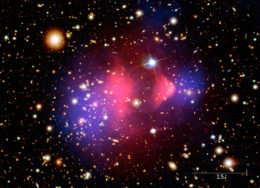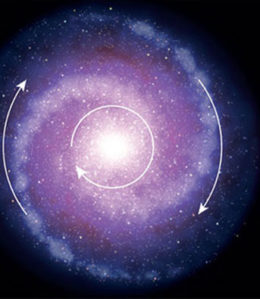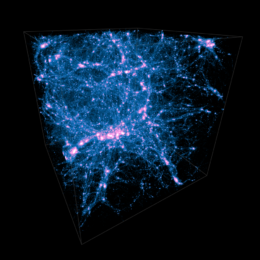Does the spin of a dark matter halo align with the spin of the galaxy it’s situated around? And what can this tell us about the early universe? Hydrodynamical simulations of galaxies in the early universe might help us answer these questions.

The Bullet Cluster of galaxies. X-rays are shown in pink and the gravitational lensing is shown in blue. This cluster is considered one of the smoking guns for the presence of dark matter. [X-ray: NASA/CXC/CfA/M.Markevitch et al.; Optical: NASA/STScI; Magellan/U.Arizona/D.Clowe et al.; Lensing Map: NASA/STScI; ESO WFI; Magellan/U.Arizona/D.Clowe et al.]
No Longer in the Dark About Dark Matter
Though the field of dark matter is expansive and exciting these days, astronomers didn’t even know dark matter existed until the 1980s. Now, dark matter can be used to probe everything from the force of gravity to galactic structure and evolution. Studying dark matter also has implications for cosmology and can help us better understand the initial conditions of the universe. Specifically, the alignment between the spins of a galaxy and its dark matter halo can help constrain the dark matter equation of state (which can tell us about the mass of the galaxy and help with predictions of its dynamics).
Taking Dark Matter for a Spin

Illustration of the spin of a galaxy. The velocity stays constant with radius, which shows that dark matter is present in the halo. [Adapted from ESO/L. Calçada; CC BY 4.0]
Illustrating What’s Happening Inside Galaxies

Simulation of the cosmic web. Every point of light is a galaxy and those galaxies are placed along filaments. [Illustris Project]
Lee and collaborators also find that properties such as black hole-to-stellar mass ratio, specific star formation rate (rate of creation of stars per unit stellar mass), and average metallicity either correlate or anticorrelate with the angle between the galaxy stellar and dark matter spins.
Future work will involve finding direct evidence for the scenario of decoupling between the spins of the galaxy and its dark matter halo earlier in the universe’s history, modeling it, and exploring its connection to the initial conditions of the universe.
Citation
“How Do the Galaxy Stellar Spins Acquire a Peculiar Tidal Connection?,” Jounghun Lee et al 2022 ApJ 927 29. doi:10.3847/1538-4357/ac4bda
![Spinning Halos in the Cosmic Web Galaxy with a big halo [made of dark matter] surrounding it](https://aasnova.org/wp-content/uploads/2022/03/halo-702x336.jpg)